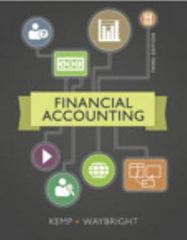Answered step by step
Verified Expert Solution
Question
1 Approved Answer
Application: Estimating Financing Needs In your accounting course, you learned about the income statement that provides a record of what led to net income for
- Application: Estimating Financing NeedsIn your accounting course, you learned about the income statement that provides a record of what led to net income for the year. Just as you might develop a forecast of the future year's budget, financial professionals forecast future income by developing a one-year forecast of the firm's income statement, more commonly known as the pro forma income statement. Taken together with assumptions about future assets, liabilities, and retained earnings, one can estimate future long-term financing needs for the corporation.For this Assignment, complete Problems 17-7 (one year pro forma statement) and 17-8 (total liabilities estimation and forecast of long-term debt financing need) in your course text. In addition, provide two or more suggestions on what Ambrose Inc. could do to reduce the forecasted debt financing (the managerial part of financing). Be sure to provide rationales as to why your suggestions will be effective in reducing the forecasted debt financing need.Submit your Assignment (both your Excel and Word files) by Day 7.General Guidance on Assignment Length: Your Assignment, due by Day 7, will typically be 23 pages in length as a general expectation/estimate. Refer to the rubric for the Week 6 Assignment for grading elements and criteria. Your Instructor will use the rubric to assess your work.To submit your Assignment, click on Assignments on the course navigation menu. Locate the Assignment Turnitin Week 6 link, then click on the View/Complete link, and follow the on-screen instructions for submitting your Assignment.
 Estimating Financing Needs Problem 17-7 & 17-8 PRO FORMA INCOME STATEMENT At the end of last year, Roberts Inc. reported the following income statement (in millions of dollars) Sales Operating costs excluding depreciation EBITDA Depreciation EBIT Interest EBT Taxes (40%) Net Income $3,000 2,450 $ 550 250 $ 300 125 $ $ 175 70 105 Looking ahead to the following year, the company's CFO has assembled this information: Year-end sales are expected to be 10% higher than the $3 billion in sales generated last year. Year-end operating costs, excluding depreciation, are expected to equal 80% of year-end sales. Depreciation is expected to increase at the same rate as sales. Interest costs are expected to remain unchanged. The tax rate is expected to remain at 40%. On the basis of that information, what will be the forecast for Roberts' year-end net income? 17-8: LONG-TERM FINANCING NEEDED At year-end 2015, total assets for Ambrose Inc. were $1.2 million and accounts payable were $375,000. Sales, which in 2015 were $2.5 million, are expected to increase by 25% in 2016. Total assets and accounts payable are proportional to sales, and that relationship will be maintained; that is, they will grow at the same rate as sales. Ambrose typically uses no current liabilities other than accounts payable. Common stock amounted to $425,000, in 2015, and retained earnings were $295,000. Ambrose plans to sell new common stock in the amount of $75,000. The firm's profit margin on sales is 6%; 60% of earnings will be retained. What were Ambrose's total liabilities in 2015? How much new long-term debt financing will be needed in 2016? (HINT: AFN-New stock = New long-term debt.)
Estimating Financing Needs Problem 17-7 & 17-8 PRO FORMA INCOME STATEMENT At the end of last year, Roberts Inc. reported the following income statement (in millions of dollars) Sales Operating costs excluding depreciation EBITDA Depreciation EBIT Interest EBT Taxes (40%) Net Income $3,000 2,450 $ 550 250 $ 300 125 $ $ 175 70 105 Looking ahead to the following year, the company's CFO has assembled this information: Year-end sales are expected to be 10% higher than the $3 billion in sales generated last year. Year-end operating costs, excluding depreciation, are expected to equal 80% of year-end sales. Depreciation is expected to increase at the same rate as sales. Interest costs are expected to remain unchanged. The tax rate is expected to remain at 40%. On the basis of that information, what will be the forecast for Roberts' year-end net income? 17-8: LONG-TERM FINANCING NEEDED At year-end 2015, total assets for Ambrose Inc. were $1.2 million and accounts payable were $375,000. Sales, which in 2015 were $2.5 million, are expected to increase by 25% in 2016. Total assets and accounts payable are proportional to sales, and that relationship will be maintained; that is, they will grow at the same rate as sales. Ambrose typically uses no current liabilities other than accounts payable. Common stock amounted to $425,000, in 2015, and retained earnings were $295,000. Ambrose plans to sell new common stock in the amount of $75,000. The firm's profit margin on sales is 6%; 60% of earnings will be retained. What were Ambrose's total liabilities in 2015? How much new long-term debt financing will be needed in 2016? (HINT: AFN-New stock = New long-term debt.) Step by Step Solution
There are 3 Steps involved in it
Step: 1

Get Instant Access to Expert-Tailored Solutions
See step-by-step solutions with expert insights and AI powered tools for academic success
Step: 2

Step: 3

Ace Your Homework with AI
Get the answers you need in no time with our AI-driven, step-by-step assistance
Get Started


